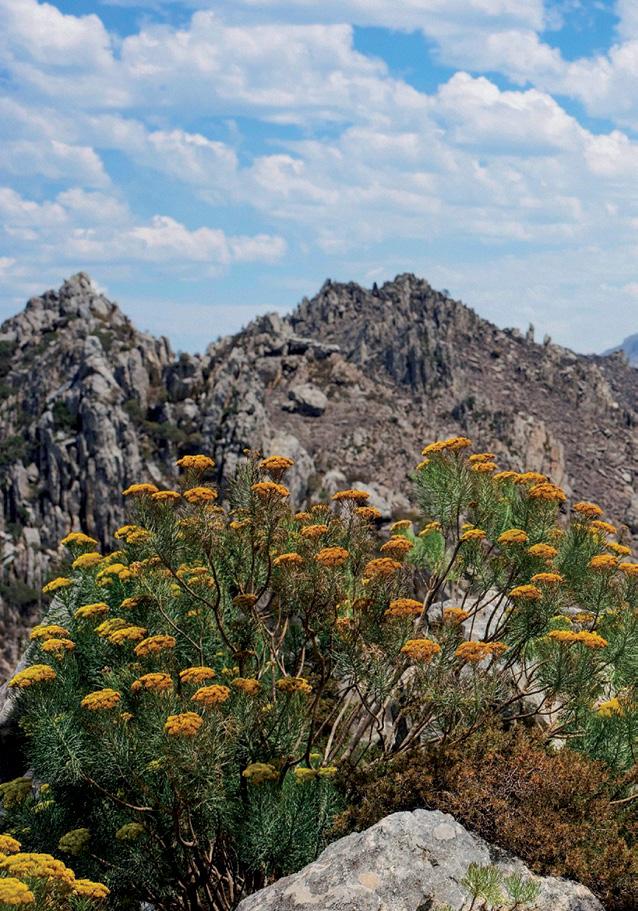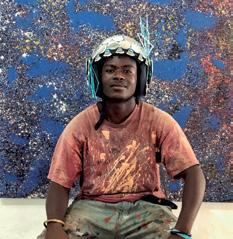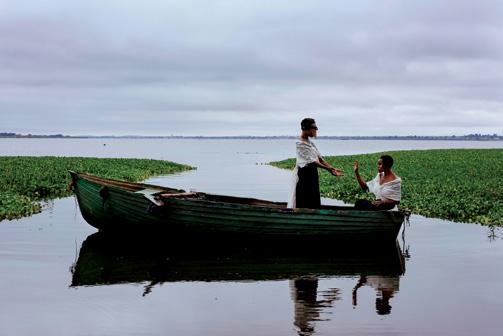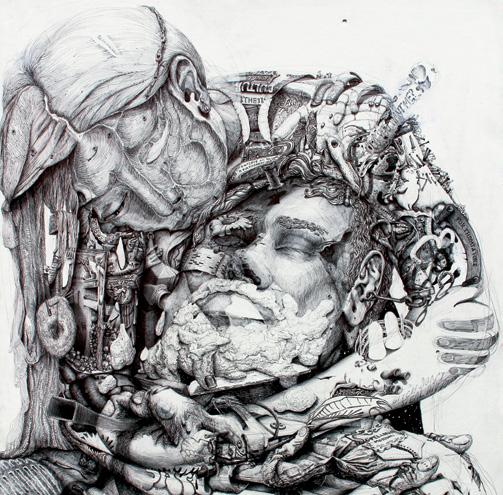
10 minute read
STELLENBOSCH TRIENNALE 2020
ART TOURISM COMES TO THE CAPE
Summer 2020 will be remembered in South African art and tourism circles as the time when the Cape – Cape Town and Stellenbosch – emerged as a fully fledged art tourism destination. Melvyn Minnaar looks forward to what visitors can expect.
Advertisement

Featured in Stellenbosch Visio, summer 2019/2020 edition Written by Melvyn Minnaar

ART TOURISM has always been a big deal. Cultural expression tickles the fancy of foreigners. It inspired wayfarers in ancient times to visit strange temples and exotic palaces, and more recently to go to places of ritual and celebration. It compels crowds to turn up in their thousands at events like the Venice Biennale and festivals like Frieze and Documenta to ogle art and what may pass as art. It gets travellers to pack their bags and cameras and take journeys to other corners of the Earth, where artists do things differently.
Creativity is a remarkable drawcard. Cultural curiosity can be a high-powered economic driver.
Nowhere is this more evident than in our own backyard. Between them, Cape Town and Stellenbosch are hosting a summer of art that is set to be the focus of a strong invasion of art tourists. And uniquely so, for a number of factors have dropped perfectly into place for what can only be described as a remarkable African art ecosystem that has been established at the continent’s southern tip.
Yet this may not be a once-off summer, for numerous cultural institutions have coordinated their efforts and shared their skills and displayed truly global professionalism. They are breaking new ground and look set to make the Cape a meaningful centre for international visitors in search of that energising cultural fix.

Above: Lazaro Samuel Photo (photo by Valerie Amani) Right: Victor Ehikhameno, The Prayer Room, Dakar Biennale, Dakar, 2016



Above: Malebona Maphutse, When gods Battle Mortals (A Revival). Opposite Page: Canon Rumanzi, ALL-HANDS-ONDECK- building-better-babel-beta.

February will be the month when all art breaks loose. Coinciding with the inaugural Stellenbosch Triennale 2020, which opens on 11 February, the eighth Investec Cape Town Art Fair annexes the Valentine’s weekend of the 14th, while the crowd-drawing master retrospective shows of William Kentridge continue at Zeitz MOCAA and the Norval Foundation. Also in February, the 26th is the first day of the globally recognised Design Indaba at the Cape Town International Conference Centre. And in March, Stellenbosch University’s widely popular Woordfees comes to town.
It goes without saying that the natural beauty of the Cape, the landscape and the weather, as well as the urban configuration, make it an ideal setting for this new art ecosystem. Tumelo Musaka, who curated the Investec Cape Town Art Fair for several years, has stressed the city’s place on the African continent.
“Cape Town’s geography is an integral part of Investec Cape Town Art Fair’s success. The city is a vibrant cultural hub, attracting
international collectors with the novelty of diverse, cutting-edge art and a favourable exchange rate.”
One can obviously add that, from a tourist’s point of view, all the add-on pleasures of visiting are on tap: top-notch facilities and fine restaurants, museums, theatres, music and fun. (Is there any other place in the world that can boast an art event of this nature within easy reach of one of the finest and most colourful winelands in the world?)
Talks, cultural platforms and walkabouts have become established facets of the Investec Cape Town Art Fair, as have the exhibition sections of this popular show at the Cape Town International Conference Centre. In the 2020 edition, Solo consists of mini-shows of artists who deserve more attention, while Tomorrows/ Today, with an eye on the moneyed, visiting collector, focuses on emerging artists. “For such artists, this publicity can go a long way towards building social interest in their career which, when well exploited, could translate to further opportunities,” says current curator Nkule Mabaso.
The theme of ‘up-and-coming’ is also the motivation for the Design Indaba Emerging Creatives, an adjunct to the international design conference and festival that starts on 26 February. This positive project has encouraged and supported young designers and creative personalities for the past 15 years and in 2020, it will showcase the work of 40 young people to an international audience.
Visitors will no doubt pick up on the African echo reverberating through all these events as they will on the prevalence of women in charge of the events, shows and selections.
Gentle hints of the prominence of women will be found in the two relatively new private Cape Town art institutions that slip seamlessly into this art ecosystem and that no overseas visitor should miss during their summer trip to the Cape: the Norval Foundation (with Elana Brundyn as its CEO) and Zeitz MOCAA (with Koyo Kouoh as its executive director and chief curator).
The blockbuster overview of South Africa’s most famous artist, William Kentridge, Why Should I Hesitate? will still be on view at both venues until March. The Norval Foundation will also host a show of the fine young Kenyan, Michael Armitage, and Zeitz MOCAA a solo survey by Nigerian, Otobong Nkanga. (Walkabouts are regular additions to the art on the floors and walls of these smart art spaces.)
If the leitmotiv of any art visitor during our super summer is guided by the female presence and an African air, no-one should miss that wonderful small gallery in Rosebank that was once home to Irma Stern, currently South Africa’s most famous deceased artist. Not only are numerous paintings and artworks by Stern on display, but also some of the most enchanting and beautiful African craft art that she collected. (February will have a curated exhibition featuring the nude in art on view.)
Cape Town may not have a museum dedicated specifically to historical African artworks, but the various institutions under the flag of Iziko have much to offer. Venues such as the South African National Gallery, the Castle of Good Hope, the Slave Lodge, Groot Constantia and the South African Museum are richly endowed with cultural treasures that nowadays are often getting a contemporary contextualised revamp.

Then there are the commercial and ‘alternative’ galleries in and around the Mother City. In recent years, local art dealers have schooled themselves in the skills to work, promote and sell internationally, and not just because of the treasure of talent that is so abundant here. Noncommercial galleries (the likes of the A4 Art Foundation in District Six) and community art spaces have found their own niche appeal for visitors from elsewhere.
The latter showcase the unique awareness among South African cultural operatives that producing art is not elitist and that much which was ignored under earlier regimes is only being
Donna Kukama, Chapter Q, Dem Short-Short-Falls Performed and documented at the Bijlmerramp Monument, Amsterdam, 2017-2018




Above: Sethembile Msezane, Water Bodies- Isinqumo I, (2018) Opposite Page: Lazaro Samuel Buku Jero, Acrylic on canvas, 80 x 49cm (Photo by Martin Shayo)

discovered in present times. Attentiveness to the educational aspects of art and craft production, of how it acts positively within communities and energises the social weave, has finally become part of our system.
If Cape Town’s art spaces will be hosting exhibitions with strong African relevance through the summer, the charming town of Stellenbosch, just 40 minutes from Cape Town International Airport, will be putting down what could well be a marker in South African art history. Already it is gearing up – and has been for months – for potentially the most significant local art jamboree in living memory.
Of course, that should be ‘African art jamboree’ because the focus of the first Stellenbosch Triennale (ST2020) is squarely on the amazing talent being uncovered all over our continent. As auction and international collector sales increasingly indicate, contemporary African art is very much in vogue.
ST2020 is a ground-breaking, investigative adventure whose various components will provide visitors with a range of experiences.
The culmination of years of investment in public art with sculpture displays in the town, the event is the brain child of the Stellenbosch Outdoor Sculpture Trust.
Anchoring the triennale is the exhibition Tomorrow There Will Be More of Us – a stimulating, poetic theme if ever there was one. Chief curator Khanyisile Mbongwa and her team of curators worked hard to sift through the 200 artists suggested from all over Africa and whittle the number to just the 20 whose selection of works are to be displayed in the reconfigured Old Wood Mill. Seven South African artists join others from Nigeria, Ghana, Uganda, the DRC, Kenya, Mozambique, Angola, Zimbabwe and Rwanda. Two other exhibitions will provide a wider context for ST2020: On the Cusp (young and new) and From the Vault (classic masterpieces).
The historic square of Die Braak will have a pavilion, while various other venues in Jamestown, Cloetesville and Kayamandi will make up a defined art route. ST2020 will also comprise an extended programme of music, talks, film and performances. Visitors are sure

Above: C+N Canepanerie, Danica Lundy, hey there delilah, ballpoint pen on paper mounted on canvas, 30 x 40 in 2019 Opposite Page: Teresa Kutala Firmino, Wounding boundaries red, mixed media on canvas, 79 x 108 cm, Everard Read Gallery (Image courtesy of Michael Hall)

to be particularly impressed by the extensive online open-source discovery and learning centre that will underpin the Stellenbosch event under the delightful name The Imaginarium. They will also note that local art endeavours are embedded in the community. The region is rich in art schools, while art fairs provide room for non-profit organisations.
There can be no doubt the thread running through this novel art ecosystem in the Cape is the vibrancy of youthful talent and artistic invention. The new and the dynamic of difference are cornerstones of both a noncommercial art venture like the Stellenbosch Triennale and the commercial Investec Cape Town Art Fair. They are what stimulates both serious collectors and observers attending in search of excitement and upliftment. Art lovers, if you will.
When the plans for the Stellenbosch Triennale were announced in February 2019, the presentation was strong on punting the points that would make it distinctive and be drawcards for visitors and tourists from afar. “Why visit?” asks the marketing brochure and then gives some reasons. On a serious note, ST2020 would be the only event of its kind in southern Africa and an opportunity to see unique or unseen African work in an African setting. More cheerfully, overseas visitors would find a favourable exchange rate and leave the northern winter behind to enjoy a southern summer. Tellingly, they would have an opportunity to visit a world-class art hub at the best time of year in the Cape.
According to Elana Brundyn of the Norval Foundation, “Cape Town is becoming a cultural destination with world-class institutions. We

Victor Ehikhameno, Wealth of Nations, Installation at Jogja National Museum, Indonesia

are proud of how this cultural ecosystem has evolved, changing the very fibre of our community. There is this growing confidence and excitement around what we offer the world. Museums are creators of credibility and this cluster of cultural development allows the Cape to compete with other global cities for tourism. A study by Myerscough College and others pointed out that three out of 10 visitors to London travelled there for the museums.”
Need one say more, except to celebrate the birth of this vibrant art and culture ecosystem on our doorstep and welcome the foreigners whose fancy is tickled by cultural expression – in the high African mode at the height of the Cape summer.
CONVENIENT CULTURE
Following international best practice, enterprising local agents are compiling tight and exclusive travel packages for visitors.
Hanlé Hill is the preferred operator for Stellenbosch Triennale 2020 and has customised a special small-group tour that spends three days each in Cape Town and Stellenbosch and includes a dedicated art and culture programme.










